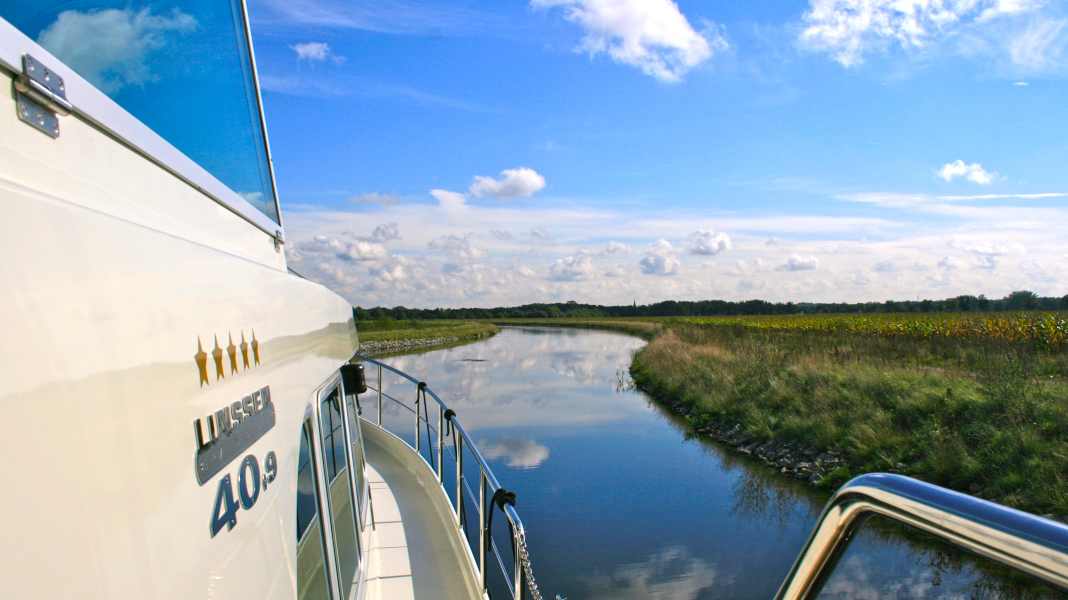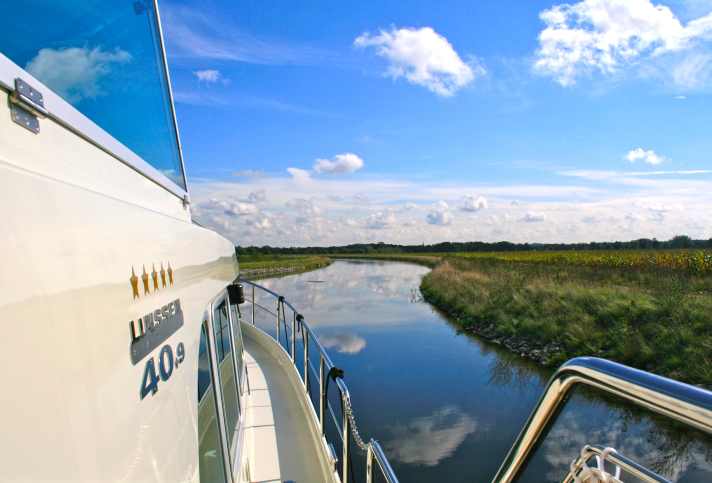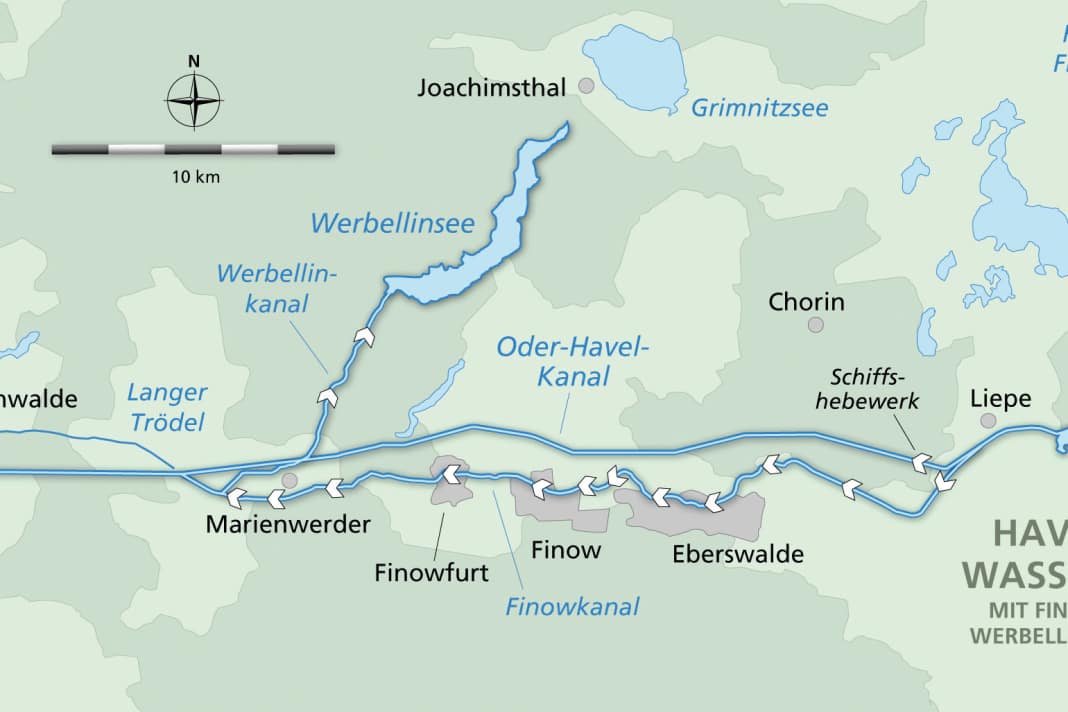







About dead ice and the sinking of an entire city, where a gold treasure disappeared to and what ostrich feathers have to do with a marina, about vendace and moray eels, about a lift for ships that is retiring and old canal systems that are coming back to life - the region to the north and north-east of Berlin has a lot to tell.

Fortunately, this part of Brandenburg is also rich in waterways. Werbelliner Gewässer and the Finow Canal are among them. Both promise tranquillity. Wasn't Lake Werbellin Fontane's "fairytale place"? And hasn't the Finow Canal been in operation for an astonishing four centuries? Our charter cruise will show you what the area has to offer.

The Upper Havel Waterway
We set off on the Upper Havel waterway. In the Zehdenick marina, home of 5 Sterne Yachtcharter, we take over an immaculate Linssen Grand Sturdy 40.9 AC. The beautiful lady, who goes by the name of "Europa", is to take us via the Upper Havel Waterway (OHW), Malz Canal (MzK) and Havel-Oder Waterway (HOW) to the Werbellin Waters (WbG).
We then want to travel down the Finow Canal (FiK) to the Havel-Oder waterway and then be lifted back up by the Niederfinow boat lift. The HOW and OHW will take us back to Zehdenick. We have one week for this tour.
Our first stage should lead from Zehdenick to the Havel-Oder waterway. The OHW section from Zehdenick to Liebenwalde, the Voss Canal, is around 16 kilometres long. From Liebenwalde to the Havel-Oder waterway is the Malzer Canal, which is around 3 kilometres long. Three locks have to be passed between Zehdenick and HOW, each of which is automated.
The operation of the Zehdenick lock and the opening of the nearby Zehdenick drawbridge are linked. Just below the Liebenwalde lock, the last lock before the MzK joins the HOW, there should be a mooring facility for pleasure craft. We set our sights on that.
It's a good thing that the weather is pretty dull today. And as cosy as the route is, we are longing for a quiet spot ahead of time. Still above the Liebenwalde lock, we call at the Liebenwalde marina. A good decision, not only because there is no designated marina for pleasure craft in the waters below the Liebenwalde lock, as we discover the next day. The small Liebenwalde marina is also a great address. Marina owner Horst Helbig greets us at the jetty: "I'd just like to say hello. And a warm welcome!"
The beautifully situated jetty has about 20 guest berths with water and electricity connections. The sanitary building is proper and well-maintained - like everything here. The centre of Liebenwalde with its shops and restaurants is within easy walking distance. Cultural tip: a few hours in the local prison. The Liebenwalde local history museum is housed in the former town prison (www.museum-im-knast.de). It also tells the story of the Finow Canal.
In Liebenwalde, the westernmost section of the Finow Canal, the "Lange Trödel", meets the Voss Canal, now the OHW, and the Malzer Canal. The Liebenwalde marina is located right at the junction, which explains its nickname: "Langer Trödel" jetty. Since the mid-1920s, the "Lange Trödel", which connects Liebenwalde with the HOW south-east of Zerpenschleuse, has lain dormant. But this is set to change in the near future. As part of the North Brandenburg Water Tourism Initiative (WIN), there are plans to make the approximately 10-kilometre stretch of canal navigable again. It should be ready in 2012/13.
The waters of Werbellin
Too late for us. We have to take the Malz Canal to get to the Havel-Oder waterway. After a good 14 monotonous kilometres of HOW, we spot a junction on the port side - the access to the Werbellin waters, more precisely to the Werbellin Canal (WbG-km 3.4-10.5) and Werbellinsee (WbG-km 10.5-20.0). We put in our oars.
An enchantingly beautiful world awaits us - seemingly unspoilt nature. We drive through the forest. The air is fresh and spicy, it smells of damp leaves. A strong autumn sun has made it glow, and here and there the first leaves tumble onto the water, which is so clear that we can make out the bottom of the canal.
At times, the Werbellinkanal seems very narrow and we secretly think to ourselves: No oncoming traffic now!
But there is enough space. Ships up to 5.10 metres wide are allowed to navigate the waters, and our "Europa", at 4.30 metres wide, remains well below the specified width. According to the charter company's data sheet, her draught is 1.20 m, which corresponds exactly to the maximum draught permitted on the Werbellin waters. Nevertheless, the depth alarm on the depth sounder keeps going off. But even then, the display regularly signals around 0.40 metres of water under the keel. The transducer may only be tickled by greenery stretching towards the light from below, especially where the canal crosses a pond.
On this trip, the echo sounder will beep excitedly a few more times. It never got "tight" down below. The two self-service locks in the Werbellinkanal, Rosenbeck and Eichhorst, are quickly passed. Then, after a total of seven enchanted kilometres of canal, the water opens up. Almost immediately we have 15 metres of water under the hull. We are on the Werbellinsee.
Lake Werbellin
The Werbellin, a "channel lake" formed during the last ice age, is up to 60 metres deep. Meltwater and dead ice - inactive glacier remnants that are protected from rapid melting by deposits - gave it its shape. Ice masses not only created Lake Werbellin, they also modelled the entire region. Our charter cruise actually takes us through mighty glacial valleys. And the hills all around are in fact moraines, pushed up by the glaciers of the last glacial period, which ended around 15,000 years ago.
We are in the mood for vendace. The vendace, as it is actually called, is considered the most important commercial fish of the Werbellin. Smoked to a golden colour, it is a real delicacy. After mooring the "Europa" in the Werbellinsee marina on the north-western shore of the lake, we set off in search of the tasty morsels, which weigh around 100 grams. Too bad: The nearby Werbellinsee fishery with its fresh food counter and adjoining snack bar is closed today, Monday. The "Seerandperle" just opposite is closed.
They serve schnitzels of colossal proportions, the waitress tells us as soon as we enter the restaurant. That's right, the schnitzels are gigantic. And delicious to boot. It's just under 5 kilometres from the Werbellinsee marina in the Elsenau district to Joachimsthal.
For those who rely on their own muscle power: At the beginning, the trail climbs steeply. After about 1.5 km, you reach the restored Schorfheide Imperial Railway Station, which is still connected to the public railway network and has a café (www.kaiserbahn hof-schorf heide.de). There are also a few shops in Joachimsthal, as well as an information office for the Schorfheide-Chorin biosphere reserve.
For centuries, it was a refuge for the powerful. Hunting rights and high politics were cultivated, shielded and aristocratic, no matter which ruler was calling - emperor or king, brown partisan or red comrade. We are talking about the Schorfheide, a forest landscape that is rarely found in Germany. As part of the Schorfheide-Chorin biosphere reserve, it is now under the care of UNESCO.
Here, at Werbellin, we are in the heart of the biosphere reserve. Evening has fallen and a strange atmosphere has settled over the lake. Its shores rise up in darkness. The cry of a night bird wafts across, then a hunting signal. On the surface of the water, fish are snapping at mosquitoes and soon dive down again. Is it really down there, the legendary Werbellow? It has long been rumoured that pride once caused the town to mysteriously sink into the lake. "It is a fairytale place where we are sitting," wrote Theodor Fontane around 130 years ago, "because we are sitting on the banks of the Werbellin." A fairytale place, yes, that's what it is.
We cast off early the next morning. The Werbellinsee marina was a good place for the "Europa". We discover another harbour that is equipped for boats of this size in Altenhof on the eastern shore of the lake. The beautifully situated marina, built in 2011, also has all the usual facilities. We recommend the "Alte Fischerei" restaurant right on the lake for a bite to eat. This pub has mooring facilities for boats - and a fish shop if you're in a hurry.
Werbellinsee (WbG-km 20.0-10.5) and Werbellinkanal (WbG-km 10.5-3.4) are behind us. We only briefly cross the Havel-Oder waterway and then take a special stretch of canal under the keel: the "new" old Werbellin Canal (WbG-km 3.0-0.0). The stretch went online in June 2011 and takes us directly to the Finow Canal (see BOOTE 8/11). Since the beginnings of the Finow Canal in the 17th century, attempts have been made to utilise the seemingly inexhaustible water reservoir of Lake Werbellin.
The Werbellin Canal, dug in the 18th century from Lake Werbellin to the Finow Canal near Ruhlsdorf, was intended to provide a solid basis for feeding the Finow Canal. However, Lake Werbellin proved to be an inadequate source of water. And when the Finow Canal was replaced by a new Havel-Oder connection, the HOW, in 1914, the Werbellin Canal was also affected. Its southern course between HOW and Ruhlsdorf was extensively filled in. The fact that there is now a connection to the Finow Canal again is - like the planned reactivation of the "Lange Trödel" - thanks to the Water Tourism Initiative North Brandenburg (WIN).
Understandably, the recently opened southern section is (still) visually inferior to the wild and romantic northern section of the Werbellinkanal. However, the attractive route, meandering gently between fields, is already appealing. And nature will take care of the rest.
The Finow Canal
Now the Finow Canal, the historic link between the Havel and Oder rivers. Germany's oldest canal still in operation branches off from the Havel-Oder waterway at HOW-km 57.4 and HOW-km 89.3. The 12 manually operated locks of the approximately 32 km long Finow Canal overcome a good 36 metres in altitude. Coming from the Werbellinkanal, we meet the Finow Canal above the Ruhlsdorf lock.
A special feature is immediately noticeable: the lock entrance and exit are offset from each other. All the locks on the Finow Canal have this construction feature, which dates back to a Prussian order from 1817 and was intended to increase the capacity of the locks. In the middle of the 19th century, the increasing size of ships required a further instruction: on certain waterways, including the Finow Canal, a maximum ship size of 40.20 m x 4.60 m was stipulated.
This "Finowmaß" is considered to be the first such standard in Germany. Originally, exactly two Finowmaß barges, lying side by side, could be operated in the locks of the Finow Canal. Maximum ship dimensions on the Finow Canal today: 41.50 m x 5.10 m.
After the second lock - Leesenbrück - we pass the Marienwerder landing stage, a simple wooden jetty. Rather than lingering, we are tempted to continue. The water becomes more pristine with every metre. There's not much going on, which is understandable as the canal goes into winter break in a few days, on 30 September. And so we keep to ourselves on this wondrous forest walk on the water. After the third lock, Grafenbrück, we end the day in the midst of nature, at the jetty of the "Eisvogel" marina.
The manageable facility has around six guest berths. It offers the usual supply options, as well as decent sanitary facilities and other amenities such as a bread roll service. The fact that we are staying in the marina is due to the slightly higher water level in the canal. Normally, it is not advisable to head for the harbour with a draught of more than 1.10 metres. But today there is enough water for the "Europa". Fortunately - the "Eisvogel" marina is a place to feel at home.
"How about ostrich liver sausage?" the harbour master asks us when we approach him. We are used to beavers, nutrias and other rare creatures in this Brandenburg wilderness, but ostriches, and then as an original meat product? "Or maybe it should be a Puschel?" The start of a cheerful conversation is made. The thing is: The Marina snack bar also sells products from a local ostrich farm, including feather dusters made from ostrich feathers, the aforementioned "Puschel".
The ostrich ham we take with us will be served on board tonight. Because it's about three uncomfortable kilometres to Finowfurt. Just as far away from the harbour is a place of interest: the Aviation Museum (www.luftfahrtmuseum-finowfurt.de).
It has raised its head and is watching us without shyness. We can make out its dark, shimmering eyes and the mighty antlers: a stag, just a few metres away from us on the bank. Haze hovers over the canal, which stretches out in front of us like a dark ribbon - towards the morning sun. We are on our way to Eberswalde.
About two kilometres down the canal from the "Eisvogel" marina, we come across the WSC Alte Mühle. The small harbour facility (clearance height 4 m, width 6 m, depth 2 m) was already fully booked for the night around midday yesterday. We would have been close to the harbour, but Finowfurt is also quite unspectacular.
At around 9 a.m. we are in front of our first lock today, Schöpfurth, as agreed. Everything is ready. And while the "Europa" sinks, we are reported on again by mobile phone. The lock operation on the Finow Canal works, at least during our visit. The Ruhlsdorf and Liepe entrance locks are operated by employees of WSA Eberswalde, while the ten remaining locks are operated by administrative assistants. There is always time for a chat and good advice.
Eberswalde
1648, the Thirty Years' War is finally over. The destruction it has left behind is immense, and the Finow Canal, completed in 1620, is also devastated. It was not until around a hundred years later, in 1746, that the "second" Finow Canal went into operation. It put the Finow Valley at the centre of Brandenburg's industrialisation and contributed to the region's economic progress. Evidence of this past can now be seen more and more frequently in the Eberswalde area - such as the brassworks harbour, which is now a simple resting place for water hikers. The water tower and the brassworks settlement are excursion destinations nearby (www.wasserturm-finow.de).
After two more locks - Heegermühle and Wolfswinkel - we can look forward to an "extra sausage": the lift bridge in Eberswalde is opened out of turn for the WSA ship travelling ahead of us, and we are allowed to join it. Very practical, as the bridge has a reputation as a bottleneck, as it is only lifted every two hours.
The Familiengarten jetty is located in the underwater part of the Drahthammer lock. From here, it is about a five-minute walk to the park of the same name. Its themes: Gardens, industrial history and other amusements (www.familiengarten-eberswalde.de). The Kupferhammer lock is followed by the graffiti-covered Finowkanal-Park jetty.
The Eberswalde city lock rest area is no feast for the eyes either. After consulting the lock keeper, we finally moor in the underwater section of the Eberswalde city lock. It's a good place to stay, even without service. We stroll through the city centre to the "Bierakademie", a traditional pub with an impressive selection of beers, although on closer inspection there are no big surprises.
The trendy restaurant "Matisse" in the stylishly restored Altstadt Carrée is like modern Eberswalde: fresh and lively. The town has a lot to offer, such as a zoo (www.zoo.eberswalde.de). And it has a treasure trove of priceless gold. This means that Eberswalde only has a copy of it, as the original - unearthed in 1913 in the brassworks settlement - was first taken to Berlin and then lost in 1945. 81 individual pieces, 80 per cent fine gold and weighing a total of 2.59 kg - all gone.
Germany's most spectacular Bronze Age gold treasure was lost for almost 60 years, but its whereabouts are now known - Moscow, Pushkin Museum. A replica of the gold treasure can be admired in Eberswalde, exhibited in the historic Adler Pharmacy, itself one of the most important architectural monuments in Brandenburg (www.eberswalde.de).
We passed the Ragöse lock (rest area in the tailwater) and Stecher lock, as well as the Niederfinow bascule bridge. Almost imperceptibly, the area has turned into an open hilly landscape. All of a sudden we see a steel structure in the distance - grey and angular: the Niederfinow boat lift on the Havel-Oder waterway, which was commissioned in 1934. That's where we want to go.
Niederfinow boat lift
Just 400 metres below the Liepe lock, we reach the confluence of the Finow Canal and the HOW.
800 metres further on we reach our destination. The boat lift towers 52 metres high in front of us. We can enter the trough straight away without having to moor up at the marina first. As the trough rumbles into motion and lifts man and mouse 36 metres within five minutes, our gaze falls on the neighbouring construction site.
The new Niederfinow boat lift is being built here. When it goes into operation in 2014, the historic boat lift will still be in operation for the time being. But then it will be decommissioned and become a monument. The thought of one day finding the old ship's hoist in retirement makes us quietly wistful. But for now, we are taking the "Europa" back to Zehdenick via HOW and OHW.

